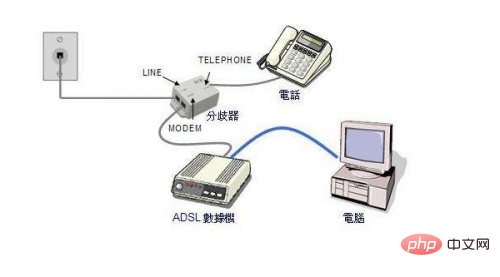Home >Common Problem >What is the difference between Ethernet and Broadband?
Difference: Ethernet is the most common communication protocol standard used in existing local area networks today. Ethernet transmits information packets between interconnected devices at a rate of 10-100Mbps; broadband is not strictly defined. Generally 56Kbps is used as the dividing line, and access methods of 56Kbps and below are called "narrowband", while access methods above are classified as "broadband".

#The operating environment of this article: windows10 system, thinkpad t480 computer.
What is the difference between Ethernet and broadband?
Ethernet connection: The local connection only appears in the Microsoft Windows XP/7 operating system. In the Windows 8/8.1 system, the local connection is renamed "Ethernet". Both "Local Area Connection" and "Ethernet" are actually reflections of the physical network card (network adapter) on the computer.
Ethernet is the most common communication protocol standard used in existing local area networks today and was established in the early 1970s. Ethernet is a commonly used local area network (LAN) standard with a transmission rate of 10Mbps. In Ethernet, all computers are connected to a coaxial cable, using the Carrier Sensing Multiple Access with Collision Detection (CSMA/CD) method, using a contention mechanism and bus topology. Basically, Ethernet consists of a shared transmission medium, such as twisted pair cable or coaxial cable, and a multiport hub, bridge, or switch. In a star or bus configuration, hubs/switches/bridges connect computers, printers, and workstations to each other via cables.
Broadband network is also called "broadband network" or simply "broadband". We know that although the speed of dial-up Internet access has increased from 14.4Kbps to 56Kbps in just a few years, due to the quality of telephone lines, 56Kbps should be the limit of general modems. If you want to get faster Internet speed, you have to go to Pixi Trail. Therefore, in recent years, various broadband access services have appeared one after another. So, what is broadband? In fact, there is no strict definition. Generally, the current upper limit of dial-up Internet speed of 56Kbps is used as the dividing line. Access methods of 56Kbps and below are called "narrowband", and access methods above are classified as "broadband". Broadband also refers to an access technology that can use different channels for multiple transmissions on the same transmission medium, and the transmission speed is above 1.5 Mbit/s. Compared with traditional Internet access technology, the biggest advantage of broadband access technology is that the access bandwidth is greatly expanded, which is generally 30 times that of ordinary dial-up Internet access.
Broadband access has always been pursued by the entire Internet industry and the majority of netizens. Broadband access solutions currently open to the public include ADSL technology based on current telephone lines, CABLE MODEM technology based on existing cable TV lines, FTTB broadband technology based on re-laying optical fiber, broadband satellite technology, and local multi-point distribution system LMDS technology wait. At the current stage, ADSL and CABLEMODEM are the most feasible. They do not require rewiring, and the access equipment and usage costs are relatively low. The broadband access method is already similar to Ethernet access. In terms of stability, it is much stronger than ADSL. ADSL is an asymmetric digital subscriber line. Although the access is a public network dynamic IP, it is still limited by the operator's public network export speed.
The "broadband connection" often seen in Windows computers is essentially a virtual connection line. After the Windows operating system is installed, the user needs to manually create the "Broadband Connection" icon.

The difference between Ethernet and broadband
Ethernet is the most common communication protocol standard used in existing local area networks today. This standard defines the cable types and signal processing methods used in local area networks (LANs). Ethernet carries packets of information between interconnected devices at a rate of 10-100Mbps. Ethernet may operate in two modes, half-duplex and full-duplex.
Broadband is actually not strictly defined. Generally, the current upper limit of dial-up Internet speed is 56Kbps as the demarcation. Access methods of 56Kbps and below are called "narrowband", and access methods above are classified as "narrowband". Similar to "broadband". If there must be a definition, it is the bandwidth required to transmit various media on the network that can be felt by people's senses. Therefore, it is also a dynamic and developing concept. For ordinary home users, current broadband refers to non-dial-up access network infrastructure and services with a transmission rate exceeding 1M (1M=1024KB) and enabling 24-hour connection.
If you want to read more related articles, please visit PHP Chinese website! !
The above is the detailed content of What is the difference between Ethernet and Broadband?. For more information, please follow other related articles on the PHP Chinese website!